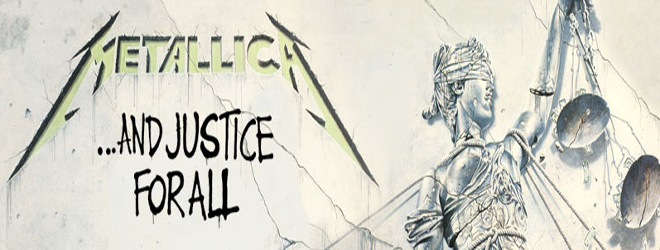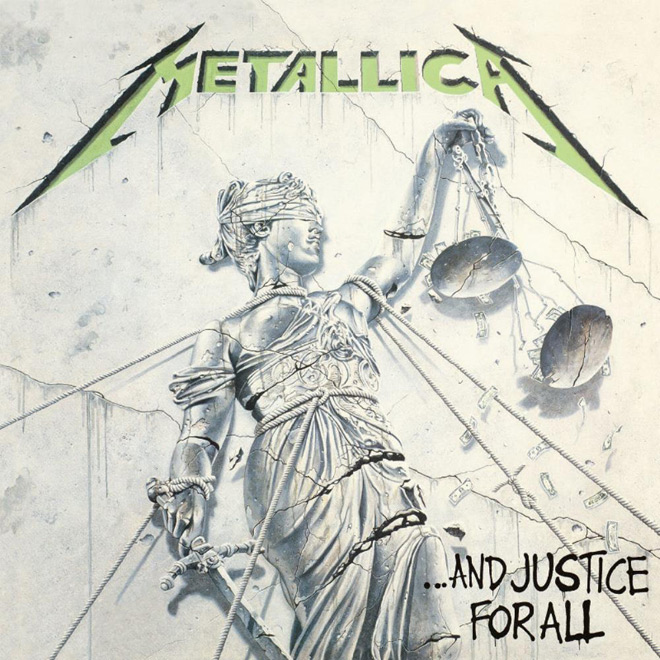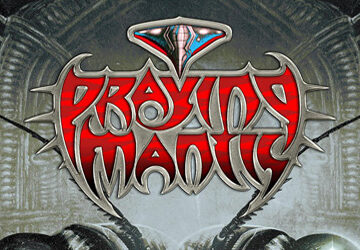By the dawn of 1988, the United States and foreign world forces were engaged in a multitude of epic political, nuclear, and wartime conflict. A global shift, these events changed the landscape of our world in ways which remain relevant to this very day. As the darker side of the 1980s came to a head, movie producers, TV writers, and even music artists used their craft to express their own views on the socio-political issues dominating the airwaves.
As arguably the most in-demand Heavy Metal act of the time, the one and only Metallica – James Hetfield (vocals), Kirk Hammett (guitar), Jason Newsted (bass), and Lars Ulrich (drums) – glimpsed into the eyes of a possibly doomed world, and dove head first into the political realm as writing began for the band’s next album.
In the swelter of summer, on August 25 of 1988, Metallica released their fourth studio album, acrimoniously entitled, …And Justice for All, on Elektra Records. More than a new album, …And Justice for All arrived during a crossroads in Metallica’s existence. The release followed three definitive moments in Metallica’s career. …And Justice for All was the follow-up to Metallica’s 1986 LP, the Metal smash, Master of Puppets, a collection considered by many as the greatest Heavy Metal album of all-time. One of the most tragic losses in music history, …And Justice for All was the first Metallica album without bass virtuoso Cliff Burton, who was killed in a tour bus accident in September of 1986. In the face of tragedy, Metallica carried on, hiring Flotsam and Jetsam Bassist Jason Newsted, a die-hard Metallica fan, and disciple of Cliff Burton.
Amid the first half of 1988, Metallica based the recording sessions for …And Justice for All at One on One Recording Studios in Los Angeles, California. At the helm, Metallica brought in renowned Producer Flemming Rasmussen to assist on production. An explosion, these sessions saw Metallica unleash bottled-up feelings of agony, success, and global political backlash, releasing it all in a stark climax.
When all was said and done, …And Justice for All turned out to be the most raw, toughest, heaviest, and outright darkest album Metallica has ever recorded. Explicit of the album’s title, …And Justice for All is ripe in twisted imagery of armageddon and the downfall of government. In addition to the music, the cover art for …And Justice for All is the brainchild of Hetfield and Ulrich, brought to life by acclaimed Artist Stephen Gorman. Burned into our memory, all Metal fans know the cover of …And Justice for All well, featuring Lady Justice beaten and bound.
Ominously,…And Justice for All opens via a sinister guitar melody, growing louder by the second, to begin the blitzkrieg of “Blackened.” A horrifying opening number, this track vividly portrays the end of the world thanks to the evils of mankind (“Death of Mother Earth, Never a Rebirth”). A Progressive Metal juggernaut, “…And Justice for All” clocks in at a numbing nine minutes and forty-six seconds, unveiling for the first time an unruly progressive side to Metallica (“Justice is lost, Justice is raped, Justice is gone”).Contradictory, “Eye Of The Beholder” exemplifies your own freedom held down by someone else’s rules (“You can do it your own way, If it’s done just how I say”).
Screaming the horrific imagery of …And Justice for All more than any other track, “One” is arguably Metallica’s most famed piece, along with being a Grammy Award winner, the band’s first Top 40 single, and first ever music video. As every Metallica fan knows, the song is inspired by the 1938 book by Novelist Dalton Trumbo and 1971 antiwar film, Johnny Got His Gun. Based in World War I , Johnny Got His Gun tells the sad story of a soldier who is injured in an explosion. Surreal, the man loses both arms and legs, and his senses of life (sight, hearing, speech) are taken from him with the exception of life itself. Remembering Morse Code, the soldier, finds a way to communicate the words “Kill Me” to doctors by blinking his eyes. Setting the scene, “One” begins with the sounds of machine-gun fire and a helicopter before those chilling opening notes of which all Metal fans have burned into their brains. In concert, Metallica is famed for giving an awe-inspiring performance of “One,” beginning and ending the song featuring explosions all over the stage.
Thrashing on, Metallica show fierce progression on “The Shortest Straw,” the head-banging “Harvester Of Sorrow,” and, an unstable cut, which Metallica played live for the very first time in 2014, “The Frayed Ends Of Sanity.” Next, …And Justice for All would not be complete without a tribute to Metallica’s fallen brother, Cliff Burton, on “To Live Is to Die.” Though Burton sadly could never record this track, Metallica found a way to posthumously place his spirit in the song. In studio, the band pieced together riffs Burton had written and named the song after a phrase Burton loved. Predominantly an instrumental, this cut does include spoken words of a poem Burton wrote during his life (“Cannot the kingdom of salvation take me home”). Closing …And Justice for All in true Metallica form, “Dyers Eve” is a psychotically fast and deranged piece, culminating all the violent and unconstrained power the band has to offer.
Conclusively, Metallica’s …And Justice for All is an unmitigated, Heavy Metal work of art, which took Metallica’s success to heavenly new heights. Climbing the mountain, ...And Justice for All quickly transformed Metallica into a multi-platinum selling act with sales of over 5 million copies worldwide. Top of the food chain, …And Justice for All soared to No. 6 on the Billboard 200 Albums Chart, becoming the first album by an underground Metal band to cap chart success in the United States. Possibly the fastest Metallica album, the song-writing is in a class by itself. As Hetfield spews out destructive lyrics, Hammett’s mechanically insane riffs dominate through quick tempo changes, while Ulrich wages double-bass drum war.
The only form of controversy, which has garnered much talk in recent years, is how the bass tracks are turned all the way down. Regardless of who requested this during the recording process and why, the move actually lends a certain quality to the memorable sound of the album. Yes, Newsted’s thunderous bass tendencies should be more audible so listener’s can hear why this young bassist was chosen to carry the flag for Cliff Burton, but if you watch the man’s live performances during the supporting tour, the proof is a sonic punch in the face.
All this said, …And Justice for All set up Metallica for the band’s mainstream debut with their next album, maybe you Metal fans have heard of it, 1991’s Metallica (a.k.a. The Black Album). The rest is Heavy Metal history. For veteran head-bangers, …And Justice for All will always be one of the sickest albums in the genre. As for fans just discovering Heavy Metal, go rush to check out Metallica’s …And Justice for All, it is a prime example of what makes Metal so awesome.




No comment